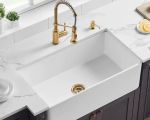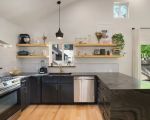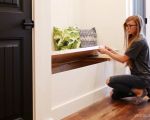Best Materials for a Bathroom Remodel: Tips for a Beautiful and Durable Finish
When it comes to remodeling a bathroom, choosing the right materials is crucial. Not only do you want your space to look beautiful, but you also need materials that will stand the test of time, especially in a high-moisture environment like a bathroom. After remodeling my own bathroom recently, I learned first-hand which materials work best for durability, aesthetics, and ease of maintenance. In this article, I’ll share some of the best materials for a bathroom remodel, drawing from personal experience and expert recommendations.
1. Tiles: The Foundation of Your Bathroom’s Design
Tiles are one of the most popular materials for bathroom remodeling, and for good reason. Whether it’s for the floor, walls, or shower, tiles are both functional and stylish. Ceramic and porcelain tiles are highly durable and resistant to water damage, making them perfect for bathroom environments.
I opted for porcelain tiles during my remodel due to their durability and wide range of designs. Not only do they look sleek, but they are also resistant to staining and scratching. For the shower area, I chose large-format tiles, which make the space appear bigger and reduce the number of grout lines, making cleaning a breeze.
Another excellent option is natural stone tiles, such as marble or granite. While more expensive, these tiles can add a luxurious feel to the bathroom and are incredibly durable. However, they do require more maintenance and sealing to prevent water absorption.
2. Countertops: Combining Function and Style
The countertop is another important element of any bathroom remodel. You want something that’s not only beautiful but also resistant to the constant moisture in a bathroom. For this reason, materials like granite, quartz, and solid surface are excellent choices.
Granite countertops are incredibly durable and heat-resistant, but they do require sealing to prevent staining. If you prefer a low-maintenance option, quartz is a fantastic choice. It’s non-porous, meaning it doesn’t require sealing, and it comes in a variety of colors and patterns that mimic the look of natural stone.
For a more budget-friendly option, solid surface materials like Corian are worth considering. They offer a smooth, modern look and are resistant to stains and scratches. I personally love the sleek, minimalist look that solid surfaces offer, especially when paired with modern fixtures.
3. Vanity and Storage: Organizing Your Bathroom Space
A good vanity can transform your bathroom both in terms of functionality and style. When selecting a vanity, it’s important to consider materials that can withstand moisture while providing ample storage space. Solid wood and plywood are great materials for vanity construction, as they offer durability and a classic look.
However, for a more modern and waterproof option, consider a vanity made from MDF (Medium Density Fiberboard) with a laminate or acrylic finish. This combination provides a sleek appearance while being resistant to moisture damage. In my remodel, I chose a modern vanity made of MDF with a high-gloss finish, which is easy to clean and gives the bathroom a contemporary feel.
4. Fixtures and Faucets: Finishing Touches that Matter
When remodeling your bathroom, don’t overlook the importance of fixtures and faucets. Choosing high-quality, durable options is key for both function and aesthetics. Popular choices for bathroom faucets include chrome, brushed nickel, and matte black finishes, all of which can complement various design styles.
For a more luxurious feel, you might consider installing a rainfall showerhead or a freestanding bathtub faucet. During my remodel, I opted for a sleek, brushed nickel faucet that complements the modern vibe of my bathroom. It’s both stylish and easy to maintain, and it doesn’t show water spots as easily as shiny chrome finishes.
5. Waterproofing: Protecting Your Investment
One of the most important steps in a bathroom remodel is ensuring proper waterproofing. Water damage can quickly lead to costly repairs, so it’s essential to invest in materials that are designed to withstand moisture. In addition to choosing waterproof tiles and countertops, you should also ensure that your plumbing is properly sealed and that the walls and floors are protected with moisture-resistant barriers.
For example, using cement board behind tiles in the shower area is a great way to prevent water damage. I made sure to use a high-quality membrane on the floors to keep moisture from seeping into the subfloor. This step might seem like an extra expense, but it’s crucial for maintaining the longevity of your bathroom remodel.
6. Lighting: Enhancing Your Bathroom’s Ambiance
Lighting plays a vital role in creating the right atmosphere in your bathroom. Whether you want bright lighting for a functional space or softer, mood-enhancing lights for relaxation, the materials and fixtures you choose can make a huge difference.
LED lights are energy-efficient and provide bright, long-lasting illumination. I chose recessed lighting for a clean, modern look, along with a large vanity mirror with built-in lighting. This setup not only brightens the space but also gives the bathroom a high-end feel.
Consider adding accent lighting around the bathtub or shower area for a spa-like experience. You could also incorporate dimmable lights, which allow you to control the intensity based on your needs and mood.
7. Eco-Friendly Materials: A Sustainable Bathroom Remodel
If sustainability is important to you, there are several eco-friendly materials that you can incorporate into your bathroom remodel. For example, bamboo is a fast-growing, renewable material that can be used for vanities, flooring, and even wall panels. Recycled glass tiles are another great option, offering a unique and stylish look while being environmentally friendly.
For my remodel, I opted for low-flow fixtures that conserve water, including the showerhead and toilet. Not only did this contribute to a more sustainable bathroom, but it also helped reduce water bills in the long run. You can also look into energy-efficient lighting and appliances to further minimize your bathroom’s carbon footprint.
Conclusion
Choosing the best materials for your bathroom remodel can seem overwhelming, but with the right knowledge and planning, it becomes an exciting and rewarding process. Whether you're focused on durability, style, or sustainability, there are plenty of materials available to fit your needs. By selecting the right tiles, countertops, fixtures, and waterproofing materials, you’ll create a beautiful, functional space that lasts for years to come. If you're ready to get started, visit [Improvement] for more tips and guidance on your bathroom remodeling journey.








